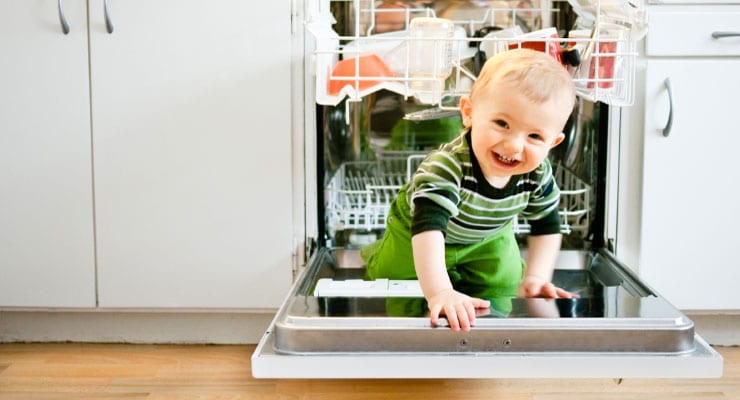Cooking with your kids can be a fun educational activity, but it requires constant vigilance. Younger children don’t yet know the dangers of the kitchen, while older kids can forget. The hazards lurking in your kitchen might surprise you—not just the risk of fire and poisoning and sharp objects, but some unexpected hazards, too. Safety consists of making sure your kitchen is kid-friendly, adopting safe cooking and preparation habits and closely monitoring your children’s behavior in the kitchen.
Ovens and Stoves
To prevent the risk of fire, keep the exhaust hood, duct, stove top and oven free of grease stains, and wipe up grease spills as they happen. Turn the handles of pots (hot or not) toward the back of the stove. Don’t fry in deep fat when kids are around. In the event of a grease fire, don’t douse it with water—cover the pot or pan or close the oven door. Lastly, it’s a good idea to maintain a short-sleeves-only rule in the kitchen. Loose sleeves and other clothing can easily catch on fire.
Poisoning Prevention
Wash your hands before you start cooking, and wash them again after handling raw eggs, raw meat or kitchen waste. Don’t let kids taste foods—such as raw cookie dough—that are not fully cooked and contain raw egg or raw meat. Use cabinet safety devices and a diligent eye to keep children away from cleaning agents, fire extinguishers or any chemical poison hazard.
Hot Objects
Not only pots and pans get hot in the kitchen. Don’t let kids, and especially very young children, within touching distance of hot objects, including the oven door. Use insulating potholders to handle hot pots and pans. Don’t let your kids pick up hot pots or pans, even with potholders—that pot you may not think is heavy could tip over, and using potholders requires some dexterity.
Warn your kids when hot objects such as ovens, stove burners, rice steamers and other appliances, stirring spoons, plates or pots come within their reach. Remind kids that foods coming out of the microwave are hot, even if they don’t seem like it. Avoid letting kids play with unheated pots and pans, since this increases the likelihood that they’ll touch them when they’re hot.
Heavy and Sharp Objects
Heavy ceramic dishes, graters, knives, cans of food, empty cans and corroded burner plates can all be hazards in the kitchen. Avoid letting kids handle objects they might break, drop or cut themselves on. Let kids use butter knives or plastic knives if they help with chopping or slicing.
Appliances
Don’t let cords dangle over the side of a counter top or tabletop. Keep appliances unplugged except when in use. Only let kids use appliances that are certified safe for children’s use. Read carefully and follow all usage and safety directions for microwave ovens and other appliances. Only let kids use the microwave if they understand all the safety precautions. Only put objects in the microwave if they are approved for microwave oven use. Don’t let kids use the microwave if their faces are at or below the level of the microwave.
Floors
An unexpected hazard is kitchen floors. Tile, linoleum and other slick surfaces can get slippery with water, grease, food or fallen objects. Don’t let kids run around in the kitchen. Wipe up all floor spills promptly.
General Kitchen Rules
Use safety gates and cabinet safety devices so young children have somewhere they can play without being in the way while you work. Make sure children can see the tops of the counters they’re using—provide a stool if not. And avoid using place mats, cloth napkins or even tablecloths around kids, since a single tug can bring everything tumbling down.
Lastly, remember that kids are creative and will investigate items you may not even think of as hazards until they hurt themselves. Prevent this happening by never leaving your kids alone in the kitchen.





